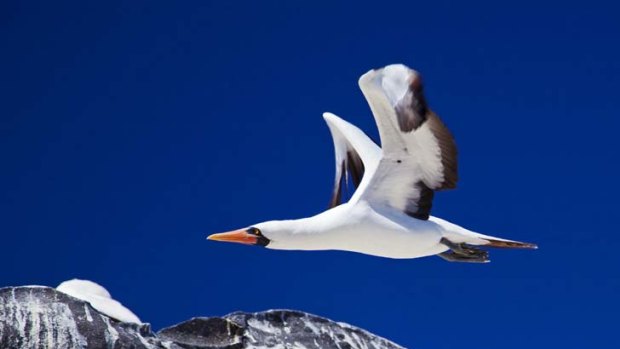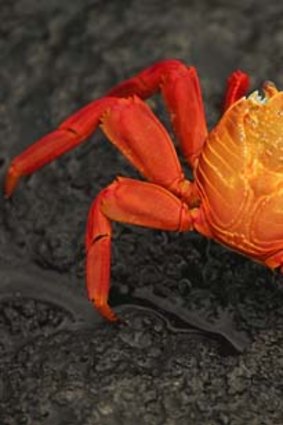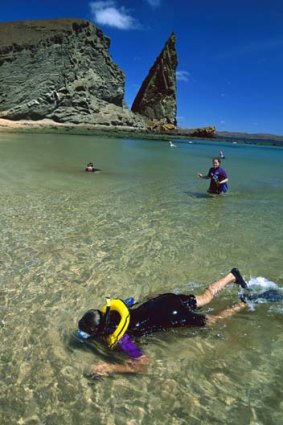
Natural selection ... Nazca booby.Credit: Getty Images
Aboard a yacht fit for a princess, Ute Junker finds the access to wildlife as exclusive as royalty could ever want.
ABOUT 1000 kilometres off the coast of South America floats a small piece of European royal history. The jaunty yacht known as the M/Y Grace was Aristotle Onassis' wedding present to Princess Grace and Prince Rainier of Monaco; the newlyweds spent their honeymoon on board.
Today, the guest list may be slightly less pedigreed but at least the itinerary is suitably exotic. The Grace will be our home for a weeklong tour of the Galapagos Islands and I'm keen to get an insider's look at how the other half sails.

A crab traverses a rocky beach.Credit: Getty Images
Being more than 60 years old, the Grace can hardly compete with the super yachts of today. However, the cabins are comfortable, there's an outdoor jacuzzi that's the perfect place to warm up after a long snorkel and, as we soon discover, the top deck is the perfect place to lounge away a lazy afternoon.
The royal connection is not, however, what made me choose the Grace from the 80-odd ships that ply the Galapagos. The first thing that appealed to me was its size. The Grace is one of the smallest boats servicing the area, taking just 18 passengers. That's a priority for me - the Galapagos is a wildlife destination, so the fewer travel companions you have, the better.
Secondly, because the boat is so small, it can visit almost any island - some of the islands are off-limits to larger ships. The M/Y Grace's itinerary is one of the most comprehensive around, taking in all the islands' top sights.

Snorkelling on Bartolome Island.Credit: Getty Images
We start at Genovesa, one of the archipelago's most outlying islands. The 14-square-kilometre plateau appears inaccessible, until we sail around a corner and see a flight of steps that takes you to the top of the 25-metre cliffs.
Stepping onto the plateau, we are met by an amazing sight. Genovesa is home to an estimated 2 million birds - boobies, tropic birds, gulls, storm petrels and short-eared owls. It has birds perched in trees, under bushes, wheeling through the air and wandering along the path. I've never been particularly ornithologically inclined but watching this amazing display, it's easy to get hooked. The shiny, black male frigate birds, which inflate their red, balloon-like gullets to attract the females, are a magnificent sight. The bird that really catches my eye, however, is the Nazca booby.
The Nazca booby is an elegant seabird, its black-and-white plumage nicely set off by an orange bill. It's not the colour co-ordination that amazes me, however; it's the sheer stupidity of the first specimen I encounter. It is nesting contentedly on the ground, apparently oblivious to the fact I'm standing just a metre away from it.
I use the term "nesting" loosely. The Nazca booby is not big on building complex nests. Judging by what's in front of me, the booby is happy to scrape the earth a bit, scatter a couple of twigs around and then lay an egg. And it's the egg that has me particularly concerned.
Nesting animals are supposed to be very protective but this booby is completely unconcerned by the fact that a potential predator - that's me - is standing right next to it. There's not even an occasional wary glance in my direction. Instead, it seems to be entertaining itself by rolling its egg around with its beak.
This bird needs a good talking to.
If I could speak booby, I'd have a few things to say. First, I would tell it not to let any other creatures get too close; they might be dangerous. (One touch of my foot would be enough to crack that egg.) I'd also suggest that it put in a bit of effort and build a proper nest that its offspring will be proud to call home. And finally, I would tell it to stop playing with that egg, or it'll break.
Of course, the booby doesn't need my advice. It's simply doing what boobies have been doing for centuries. And because it lives in the Galapagos Islands - a predator-free environment - it's going to be fine.
The Galapagos Islands have a reputation as one of the most exciting wildlife destinations on Earth. Which is quite remarkable when you consider that, unlike Africa, it has none of those terrifying predators we're so fascinated by. There are no lions, no leopards, no rhinos or hippos - not even a giraffe or an elephant. The biggest thing in the Galapagos is the giant tortoise. True, that's a pretty impressive beast - weighing up to 250 kilograms, the tortoises can live for more than 100 years and go a whole year without food - but it's hardly a contender for top of the food chain.
It's precisely this lack of predators that makes the Galapagos wildlife - which also includes sea lions, fur seals, iguanas, dolphins, sharks and whales - so fascinating. Because the animals have never had anything to be afraid of, it's easy to get up close and personal with any animal - even a nesting booby.
To make the most of the Galapagos experience, you'll need to have at least a week up your sleeve. The 13 larger islands, which are actually the tips of submerged volcanoes, are not only far removed from the mainland - Ecuador lies 1000 kilometres to the east - but also from each other, spread over an area of 8000 square kilometres. Which islands feature on your itinerary will depend on the size of your ship and the length of your trip.
Be prepared for a demanding schedule. We do three excursions every day - two on the land, one in the water, the first sometimes before 7am. After the first morning, no one complains: we realise it's the smart thing to do. This early in the day, the animals are all alert and frisky; humans are not. Few other guides can coax their charges off the boat this early, which means we get prime viewing time to ourselves. Sometimes, as we leave the island, we see the second group heading in on their inflatable pangas and feel smug, knowing we got there first.
Vegetation is sparse on the arid islands but each island has its own beauty. There are black-sand beaches on which the fur seals are lined up soaking up the sun, and white-sand beaches that look as if they've been lifted from a Caribbean brochure. On Fernandina, we see marine iguanas warming themselves on black basalt; on Santa Cruz, we see a really unexpected sight - pink flamingoes stalking through a lagoon.
Our snorkelling expeditions also bring plenty of wildlife encounters, including penguins, green turtles, hammerhead sharks and playful sea lions.
The Galapagos Islands are famous for having helped inspire Charles Darwin with ideas that led to the formulation of the theory of evolution. The islands' wildlife has evolved from ancestors that came by sea or air - often blown off course - and over time adapted to make the most of their new environment.
My favourite evolutionary survivor is the giant cormorant. Cormorants are a common sight on seashores around the world - elegant, long-necked diving birds that are fond of perching on rocks, their magnificent wings spread out to dry. They're a truly impressive sight and, watching them, you get the distinct feeling they're fully aware of the fact.
The giant cormorant, however, differs from its cousins. The Galapagos Islands turned out to be a paradise for cormorants: plenty of food within easy reach and no predators to avoid. Over the centuries, the giant cormorant not only grew to an extraordinary height - several times larger than its nearest relatives - but also found it no longer needed its wings.
The giant cormorant is now the only flightless marine bird in the world. And nature's tough - if you don't use it, you lose it. As a result, the big bird's wings have shrunk to tiny stumps. However, ingrained behaviour dies hard. When the cormorant emerges from the sea, it hops on a rock, spreads its tiny stumpy wings, and suns itself proudly as if it's king of the hill.
The writer travelled with the assistance of Natural Focus Safaris.
Trip notes
Getting there
There are no direct flights from Australia to Ecuador. LAN Airlines flies to Ecuador's capital, Quito, via Santiago de Chile. Return flights to Santiago start from $2229, lan.com. From Quito, AeroGal flies daily to the Galapagos Islands, with return flights priced about $500, www.aerogal.com.ec.
Cruising there
The M/Y Grace departs on a seven-night cruise every Saturday. Prices include all meals and non-alcoholic beverages on board, shore excursions with English-speaking guides, use of snorkelling equipment and wetsuits, Galapagos National Park fee and tourist transit card. Prices start from $6249 a person, twin share.
Next year, following the introduction of new rules for cruise operators, the M/Y Grace will offer two separate seven-night itineraries, which will operate on alternating weeks. Both itineraries will be the same price. Natural Focus Safaris, (03) 9249 3777, naturalfocussafaris.com.au.
Galapagos’s greatest hits
1 Isabela Island See giant tortoises and land iguanas, visit Darwin Lake and snorkel with turtles, rays and penguins.
2 Bartolome Island Its eerie lunar landscape sets this apart from the other islands. Climb to the summit for one of the most spectacular views in the islands.
3 Fernandina Island Home to an active volcano, Fernandina is also home to sea lions, Galapagos hawks and a large colony of marine iguanas.
4 Santa Cruz Island Visit the Charles Darwin Research Station, home to Lonesome George, the last tortoise of his kind.
5 Espanola Island Swim with sea lions and witness the mating dance of the albatross.
6 Genovesa Island Home to an estimated 2 million birds, including several species of booby.
Sign up for the Traveller Deals newsletter
Get exclusive travel deals delivered straight to your inbox. Sign up now.